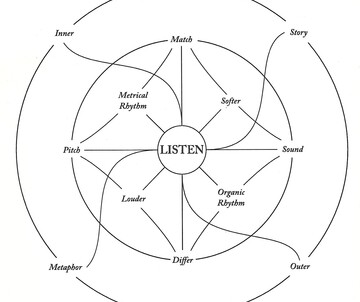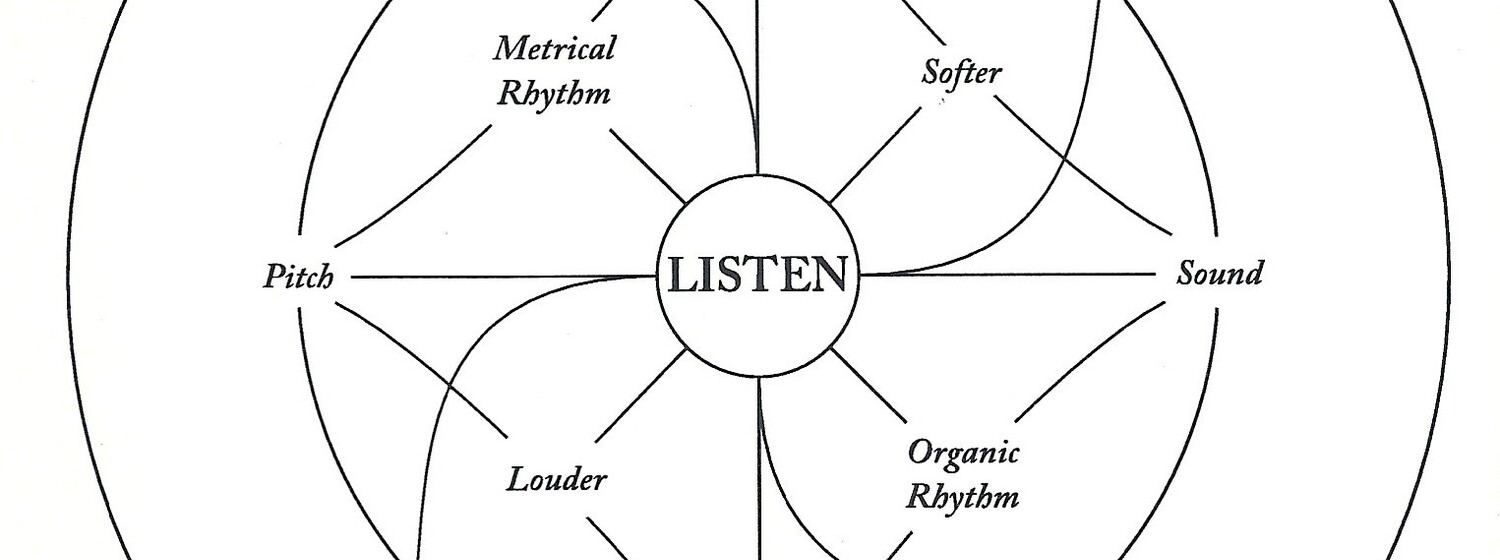21.10.2017 to 21.10.2017 - TONSPUR_passage
Host: MQ Cultural Tenants
Pauline Oliveros: Sonic Meditations
ART


Venue: TONSPUR_passage
Admission free
As part of the Phonofemme Festival, Pauline Oliveros' "Sonic Meditations" will be performed by Maria Chavez (PE/US), Maia Urstad (NO), Doug Van Nort (US/CA), Ingrid Plum (UK), Zahra Mani (AT/UK) Meriheini Luoto und Covered by Forest (FI), Paul Miller aka DJ Spooky (US), sowie Kristine Tjogersen (NO) und das Quartett Tøyen Fil og Klafferi (NO).
Pauline Oliveros Biography:
Pauline Oliveros (b. 1932) in Houston, Texas, is a composer, performer, humanitarian and an important pioneer in American music. Acclaimed internationally, for four decades she has explored sound, forging new ground for herself and others. Through improvisation, electronic music, ritual, teaching, and meditation she has created a body of work with such breadth of vision that it profoundly affects those who experience it and eludes many who try to write about it.
Oliveros has been honored with awards, grants, and concerts internationally, including the SEAMUS (Society for Electro-Acoustic Music in the US) Award for Lifetime Achievement, 1999; ASCAP Standard Award, 1982-98; and NEA fellowships in 1990, 1988, and 1984. She has performed in the world's most prestigious venues, ranging from the John F. Kennedy Center in Washington D.C. to the studios of the West German Radio. Through her Deep Listening Pieces and earlier Sonic Meditations (1971), Oliveros helped introduce the concept of incorporating all environmental sounds into musical performance. This requires focused concentration, skilled musicianship. and strong improvisational skills, which are the hallmarks of Oliveros' form.
She has also provided leadership within the music community from her early years as the first director of the Center for Contemporary Music at Mills College in 1966, to becoming director of the Center for Music Experiment during her fourteen- year tenure as professor of music at the University of California at San Diego, 1967-81. She has served as composer-in-residence at many colleges including Mills College, Oberlin College, and Northwestern University. She has also acted in an advisory capacity for organizations such as the National Endowment for the Arts, the New York State Council for the Arts, and many private foundations.
About Sonic Meditations:
In 1974 Pauline Oliveros published one of the most important works of her career, the seminal Sonic Meditations. The work broke radically from the traditions of western music. Instead of using standard music notation, the composition consisted of twenty-five Roman-numeraled prose instructions, ranging from one sentence to a few paragraphs, which presented strategies for listening. The example below, Sonic Meditation X, illustrates their general character:
“Sit in a circle with your eyes closed. Begin by observing your own breathing. Gradually form a mental image of one person who is sitting in the circle. Sing a long tone to that person. Then sing the pitch that person is singing. Change your mental image to another person and repeat until you have contacted every person in the circle one or more times (score).”
Oliveros wrote the Meditations while involved in teaching and research at the University of California, San Diego. To a certain extent, her involvement with meditation synthesized academic research with the revolutionary, consciousness-expanding characteristics of the new sensibility.
A hallmark of her work in San Diego was a fascination with long continuous sounds, such as the drones of motors, fluorescent lights, and freeway noise. Oliveros discovered that through processes of relaxation, she could listen more closely to drones, and that relaxation also helped her to gain insights into the phenomenology of listening itself. In the spirit of the new sensibility, she became interested in forms of meditation that increase awareness, such as those used in Buddhism and T'ai Chi Chuan (Oliveros, Software for People 148). She learned she could apply these forms of meditation to music making and listening with profound effect.
By 1970, several other women had joined her (many of whom were not professional musicians) to form the (“fem”) Ensemble—an all-woman improvisation group devoted to studying long sustained sounds, both vocal and instrumental. Oliveros' phenomenological analysis of listening led her to a special interest in the involuntary changes that occurred while the Ensemble sustained tones. Based on her involvement with various forms of meditation, she began to lead improvisations that encouraged spontaneous, subconscious transformation through de-emphasizing mental constructs such as "opinions, desires and speculations" (Oliveros, Software 149).
The actual sound making in the Sonic Meditations is primarily vocal, but sometimes includes hand clapping or other body sounds. Occasionally, sound-producing objects and instruments are used. Since many members of the (“fem”) Ensemble were non-professionals, the approach is radically egalitarian. Special skills are not required, anyone can participate. The principle focus is on the cognition of sound. In the second "Introduction" to the work, Oliveros writes that each Meditation is a special procedure for the following:
1. Actually making sounds
2. Actively imagining sounds
3. Listening to present sounds
4. Remembering sounds
Through her research, Oliveros concluded that the Sonic Meditations could produce healing, heightened states of awareness and expanded consciousness, changes in physiology and psychology, and new forms of communal relationships ( Sonic Meditations, "Introduction II"). "In the process a kind of music occurs naturally," she wrote. "Its beauty is not through intention, but is intrinsically the effectiveness of its healing power."
Oliveros continued this work, and by the 1980s, it led to an aesthetic philosophy she refers to as Deep Listening, which redefines listening as being an art in itself. She speaks of hearing as the "primary sense organ," and has summarized Deep Listening as follows:
"Deep Listening is listening in every possible way to everything possible to hear no matter what you are doing. Such intense listening includes the sounds of daily life, of nature, or one's own thoughts as well as musical sounds. Deep Listening represents a heightened state of awareness and connects to all that there is. As a composer I make my music through Deep Listening" (Oliveros, Website).
Oliveros' aesthetic of Deep Listening thus encompasses a very wide area of musical thought and consciousness developed over four decades of composition and research. In their practical applications, the forms of Deep Listening embodied in the Sonic Meditations hint at new types of music making, new concepts of social order, and new forms of spirituality. As the New York Times music critic, John Rockwell, has noted, "On some level, music, sound, consciousness and religion are all one, and she would seem to be very close to that level" (quoted in Oliveros, Website).
Some Central Concepts of Deep Listening as Embodied by the Sonic Meditations.
The Sonic Meditations can be quite fun to perform. They are often more intimate than normal chamber music and create unusually intense feelings of rapport among the participants. They also create a sense of safety and creative freedom since there is no "right" or "wrong" way of performing them—the bane of both professional and non-professional musicians.
The Sonic Meditations embody the concepts of Deep Listening, which include nonjudgmental perception, the development of empathy through listening, the creation of nonhierarchical social relationships in music making, the expanded use of intuitive forms of internal and external awareness, and new understandings of sensuality and the body. These practices are fundamental to Oliveros' work, and shape both her music making and teaching. She identifies creativity as fundamental to human dignity, and feels that helping others to be creative is an essential part of the artist's work. To analyze the Sonic Meditations we will look at their relationship to some of the central components of Deep Listening.
Nonjudgmental Perception.
Deep Listening cultivates forms of perception unhindered by preconceptions. One of the Deep Listener's goals is to listen to each and every sound exactly for what it is, nothing more, nothing less. The Sonic Meditations thus focus our attention on how listening is an act of cognition that can "filter" or shape auditory perception. This is illustrated in “Sonic Meditation XXII,” which asks the practitioners to think of a familiar sound, listen to it mentally, and notice how it affects them differently in various imagined contexts.
Image: William Osborne: Pauline Oliveros‘ deep listening and the sonic meditations
<link http: www.tonspur.at>www.tonspur.at
<link http: www.facebook.com phonofemme>www.facebook.com/phonofemme